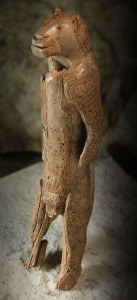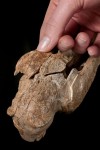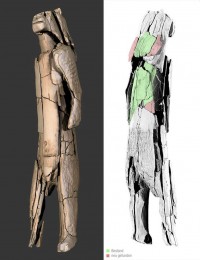 In late August 1939, geologist Otto Völzing was digging in the Stadel cave on Hohlenstein Mountain in the Swabian Alps when he found hundreds of fragments of a mammoth ivory statuette. He packed them hastily into a box but had no time to examine them. The excavation, funded by the SS, ended that very day because World War II was about to begin. The box went to the University of Tübingen and eventually found its way to the Ulm Museum. Thirty years would pass before anyone paid them any mind.
In late August 1939, geologist Otto Völzing was digging in the Stadel cave on Hohlenstein Mountain in the Swabian Alps when he found hundreds of fragments of a mammoth ivory statuette. He packed them hastily into a box but had no time to examine them. The excavation, funded by the SS, ended that very day because World War II was about to begin. The box went to the University of Tübingen and eventually found its way to the Ulm Museum. Thirty years would pass before anyone paid them any mind.
The first attempts at reconstruction in 1970 revealed a headless standing anthropomorphic figurine. During a more thorough attempt in 1988, researchers were able to glue together 220 pieces along with beeswax and chalk filler material, resulting in a lion-headed sculpture just under a foot high, 2.2 inches wide and 2.3 inches thick. Seven parallel lines are carved onto its left arm. A good thirty percent of the body was still missing, though, including a large part of the back and the entire right arm.
Early estimates put its date at around 32,000 years old, which made it one of the earliest figural sculptures ever found. It was carved with a flint stone knife out of a single mammoth tusk, then polished with leather and saliva. Recent research shows that it would have taken 400 hours to create this piece, a concentration of time that suggests this was someone’s job rather than a casual whittle after the day’s hunting and gathering. If so, that means that this Cro-Magnon community was willing to provide for artists, perhaps for religious reasons.
It’s unclear what religious role if any the figurine may have played. It might represent a mythical half-man, half-lion creature, but it could also represent a shaman wearing the hide of a cave lion for ritual purposes. It was found buried in a space deep at the back of the cave, 89 feet from the mouth. After 400 hours of work, why hide it away unless it was part of a religious practice? Many cave paintings like the ones at Lascaux and Chauvet were done in the darkest, most dangerous recesses of a cave where it would have been difficult to work. There must have been an important reason for it.
Cave paintings have also been found in France depicting animal-human hybrids and men wearing animal hides. Maybe not just men either. There has been a great deal of debate about this statuette’s gender. In the 1980s, paleontologist Elisabeth Schmid theorized that Lion Man was actually Lion Woman, that a plate below the abdomen that had been interpreted as a stylized flaccid penis is actually a pubic triangle. The Lion sculpture also has a transverse abdominal crease commonly found in female figures from the Ice Age.
 In 2009, a team of archaeologists led by Claus-Joachim Kind returned to the Stadel cave and re-excavated the find site. They sifted through all the 1939 backfill and found an additional 1,000 fragments. Some of them are minute, just a few millimeters in size, but some are substantial chips as large as a finger. They found the remains of a fire, a decorated deer tooth, an arctic fox’s tooth and some ivory beads. These could have been decorative elements from a robe, perhaps even a shaman’s animal hide outfit.
In 2009, a team of archaeologists led by Claus-Joachim Kind returned to the Stadel cave and re-excavated the find site. They sifted through all the 1939 backfill and found an additional 1,000 fragments. Some of them are minute, just a few millimeters in size, but some are substantial chips as large as a finger. They found the remains of a fire, a decorated deer tooth, an arctic fox’s tooth and some ivory beads. These could have been decorative elements from a robe, perhaps even a shaman’s animal hide outfit.
More concretely, researchers were able to radiocarbon-date bones found in Lion Man’s layer, and they are significantly older than previously thought, bringing the sculpture’s estimated age up to 40,000 years old. There are very few figural sculptures around that age known, and they are small pieces. This is the largest, most elaborate and possibly the oldest of them all. A few of the smaller unusable ivory fragments from the statue are in the process of being dated to confirm the stratigraphic results.
 With the new pieces to add and new technology at their disposal, in 2011 researchers at the State Conservation Office in Esslingen, near Stuttgart, began working on reconstructing the reconstruction. The glue from earlier attempts was dissolved and the old filler material removed. Using 3D computer modeling as a guide, the figurine is being reassembled piece by piece. The finished product will be taller, with a more complete back and some of the missing right arm in place.
With the new pieces to add and new technology at their disposal, in 2011 researchers at the State Conservation Office in Esslingen, near Stuttgart, began working on reconstructing the reconstruction. The glue from earlier attempts was dissolved and the old filler material removed. Using 3D computer modeling as a guide, the figurine is being reassembled piece by piece. The finished product will be taller, with a more complete back and some of the missing right arm in place.
The plan was for Lion Man to be reconstructed in time to be the centerpiece of the British Museum’s Ice Age Art: Arrival of the Modern Mind, which opens on February 7th, but it’s taking longer than expected so the British Museum is having to make do with a replica. Instead the revamped figurine will debut at its home base, the Ulm Museum, in November. The Return of the Lion Man: History, Myth, Magic will tell the story of its discovery, the research around it, the reconstruction process and the role technology plays in modern Ice Age archaeology.